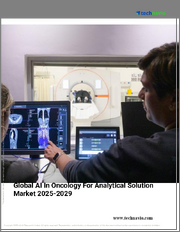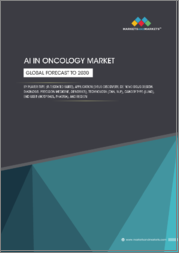
|
시장보고서
상품코드
1763997
세계의 종양학용 AI 시장 : 산업 규모, 점유율, 동향, 기회, 예측 - 컴포넌트별, 암 유형별, 치료 유형별, 지역별, 경쟁별(2020-2030년)AI in Oncology Market - Global Industry Size, Share, Trends, Opportunity, and Forecast, Segmented By Component, By Cancer Type, By Treatment Type, By Region & Competition, 2020-2030F |
||||||
세계의 종양학용 AI 시장 규모는 2024년에 7억 108만 달러로 평가되었고, 2030년까지 CAGR 9.43%로 성장할 것으로 예측됩니다.
이 시장은 세계의 암 이환율 증가나 보다 정확하고 효율적인 진단 및 치료 옵션에 대한 수요가 높아짐에 따라 강력한 기세를 늘리고 있습니다. 인공지능은 조기발견, 영상해석, 병리학적 해석, 개별화된 치료 계획을 가능하게 함으로써 종양학에서 변혁적인 역할을 하고 있습니다. 기계학습 알고리즘, 딥러닝, MRI 및 CT 스캔 등의 화상 기술과의 통합 등의 혁신은 진단 정확도를 높이고 있습니다. FDA에 의한 AI를 탑재한 암 검출 장치 인가 등의 규제상 승인이나, 정밀 종양학을 지원하는 Tempus+와 같은 플랫폼은, 채용을 가속시키고 있습니다. 게다가 헬스케어 공급자, 학술 기관, AI 기업 간의 콜라보레이션이 기술적 진보에 기여하고 있습니다. 방대한 데이터 세트를 분석하고 실시간 임상 판단을 지원하는 AI의 능력은 진단부터 치료 후 모니터링에 이르기까지 암 치료에 필수적인 도구로 자리잡고 있습니다.
| 시장 개요 | |
|---|---|
| 예측 기간 | 2026-2030년 |
| 시장 규모(2024년) | 7억 108만 달러 |
| 시장 규모(2030년) | 12억 102만 달러 |
| CAGR(2025-2030년) | 9.43% |
| 급성장 부문 | 화학요법 |
| 최대 시장 | 북미 |
주요 시장 성장 촉진요인
진단 정확도 향상
주요 시장 과제
상호 운용성 및 데이터 통합
주요 시장 동향
AI 주도의 라디오믹스
목차
제1장 제품 개요
제2장 조사 방법
제3장 주요 요약
제4장 고객의 목소리
제5장 세계의 종양학용 AI 시장 전망
- 시장 규모 및 예측
- 금액별
- 시장 점유율 및 예측
- 컴포넌트별(소프트웨어 솔루션, 하드웨어, 서비스)
- 암 유형별(유방암, 폐암, 전립선암, 대장암, 뇌종양, 기타)
- 치료 유형별(화학요법, 방사선요법, 면역요법, 기타)
- 지역별(북미, 유럽, 아시아태평양, 남미, 중동 및 아프리카)
- 기업별(2024년)
- 시장 맵
제6장 북미의 종양학용 AI 시장 전망
- 시장 규모 및 예측
- 시장 점유율 및 예측
- 북미 : 국가별 분석
- 미국
- 캐나다
- 멕시코
제7장 유럽의 종양학용 AI 시장 전망
- 시장 규모 및 예측
- 시장 점유율 및 예측
- 유럽 : 국가별 분석
- 프랑스
- 독일
- 영국
- 이탈리아
- 스페인
제8장 아시아태평양의 종양학용 AI 시장 전망
- 시장 규모 및 예측
- 시장 점유율 및 예측
- 아시아태평양 : 국가별 분석
- 중국
- 인도
- 일본
- 한국
- 호주
제9장 남미의 종양학용 AI 시장 전망
- 시장 규모 및 예측
- 시장 점유율 및 예측
- 남미 : 국가별 분석
- 브라질
- 아르헨티나
- 콜롬비아
제10장 중동 및 아프리카의 종양학용 AI 시장 전망
- 시장 규모 및 예측
- 시장 점유율 및 예측
- 중동 및 아프리카 : 국가별 분석
- 남아프리카
- 사우디아라비아
- 아랍에미리트(UAE)
제11장 시장 역학
- 성장 촉진요인
- 과제
제12장 시장 동향 및 발전
- 최근 동향
- 합병 및 인수
- 제품 출시
제13장 세계의 종양학용 AI 시장 : SWOT 분석
제14장 Porter's Five Forces 분석
- 업계 내 경쟁
- 신규 진입의 가능성
- 공급자의 힘
- 고객의 힘
- 대체품의 위협
제15장 경쟁 구도
- Azra AI.
- IBM Corp.
- Siemens Healthcare GmbH.
- Intel Corporation.
- GE HealthCare.
- NVIDIA Corporation.
- Digital Diagnostics Inc.
- ConcertAI.
- Median Technologies.
- PathAI.
제16장 전략적 제안
제17장 기업 소개 및 면책사항
AJY 25.07.16The Global AI in Oncology Market was valued at USD 701.08 Million in 2024 and is projected to grow at a CAGR of 9.43% through 2030. The market is gaining strong momentum due to the increasing global burden of cancer and the growing demand for more accurate and efficient diagnostic and treatment options. Artificial intelligence is playing a transformative role in oncology by enabling early detection, image analysis, pathology interpretation, and personalized treatment planning. Innovations such as machine learning algorithms, deep learning, and integration with imaging technologies like MRI and CT scans are enhancing diagnostic precision. Regulatory approvals, such as the FDA's clearance of AI-powered cancer detection devices, and platforms like Tempus+ that support precision oncology, are accelerating adoption. Additionally, collaborations between healthcare providers, academic institutions, and AI companies are contributing to technological advancements. AI's ability to analyze vast datasets and support real-time clinical decisions is positioning it as a vital tool in cancer care, from diagnosis to post-treatment monitoring.
| Market Overview | |
|---|---|
| Forecast Period | 2026-2030 |
| Market Size 2024 | USD 701.08 Million |
| Market Size 2030 | USD 1,201.02 Million |
| CAGR 2025-2030 | 9.43% |
| Fastest Growing Segment | Chemotherapy |
| Largest Market | North America |
Key Market Drivers
Improving Diagnostic Accuracy
AI's ability to interpret medical images with high precision is driving its adoption in oncology. By identifying complex patterns in radiological scans such as MRIs and CTs, AI supports early cancer detection and improves diagnostic outcomes. A 2022 NCBI study emphasized how AI significantly enhances the detection of mammographic abnormalities, helping healthcare professionals diagnose cancer at earlier, more treatable stages. Unlike human interpretation, which can vary due to fatigue or experience, AI delivers consistent, objective analysis. This reduces the risk of misdiagnosis and increases confidence among clinicians. Moreover, AI-driven systems support cancer screening programs by efficiently analyzing high volumes of imaging and pathology data, improving throughput and reducing diagnostic delays across healthcare systems.
Key Market Challenges
Interoperability and Data Integration
Data fragmentation across healthcare systems is a major barrier to the seamless deployment of AI in oncology. Variations in electronic health record (EHR) platforms, imaging technologies, and data formats hinder the ability to integrate and standardize patient data. For AI systems to function effectively, comprehensive access to medical history, imaging records, and genomic profiles is critical. However, lack of compatibility and uniform standards often leads to inconsistent or incomplete data inputs. This affects the reliability of AI-driven recommendations and creates trust issues among healthcare providers. Data integration challenges also slow the training and validation of AI models, ultimately impacting clinical adoption and scalability.
Key Market Trends
AI-Driven Radiomics
AI-powered radiomics is emerging as a key trend, enabling the extraction of detailed imaging features that reflect tumor behavior and biological properties. By analyzing micro-patterns and textures in medical scans, AI systems can detect cancer early, even before clinical symptoms arise. Radiomics not only improves diagnosis but also plays a pivotal role in treatment personalization. AI can link image-based features with molecular and genetic data, guiding precision therapies. Additionally, radiomics tools assist in real-time treatment monitoring by tracking how tumors respond to specific interventions. These systems enhance decision-making and reduce variability in radiological assessments. As AI radiomics becomes more integrated into oncology workflows, it is redefining standards for cancer screening, diagnosis, and outcome prediction.
Key Market Players
- Azra AI
- IBM
- Siemens Healthcare GmbH
- Intel Corporation
- GE HealthCare
- NVIDIA Corporation
- Digital Diagnostics Inc.
- ConcertAI
- Median Technologies
- PathAI
Report Scope:
In this report, the Global AI in Oncology Market has been segmented into the following categories, in addition to the industry trends which have also been detailed below:
AI in Oncology Market, By Component:
- Software Solutions
- Hardware
- Services
AI in Oncology Market, By Cancer Type:
- Breast Cancer
- Lung Cancer
- Prostate Cancer
- Colorectal Cancer
- Brain Tumor
- Others
AI in Oncology Market, By Treatment Type:
- Chemotherapy
- Radiotherapy
- Immunotherapy
- Others
AI in Oncology Market, By Region:
- North America
- United States
- Canada
- Mexico
- Europe
- France
- United Kingdom
- Italy
- Germany
- Spain
- Asia-Pacific
- China
- India
- Japan
- Australia
- South Korea
- South America
- Brazil
- Argentina
- Colombia
- Middle East & Africa
- South Africa
- Saudi Arabia
- UAE
- Kuwait
- Turkey
- Egypt
Competitive Landscape
Company Profiles: Detailed analysis of the major companies present in the Global AI in Oncology Market.
Available Customizations:
Global AI in Oncology market report with the given market data, TechSci Research offers customizations according to a company's specific needs. The following customization options are available for the report:
Company Information
- Detailed analysis and profiling of additional market players (up to five).
Table of Contents
1. Product Overview
- 1.1. Market Definition
- 1.2. Scope of the Market
- 1.2.1. Markets Covered
- 1.2.2. Years Considered for Study
- 1.2.3. Key Market Segmentations
2. Research Methodology
- 2.1. Objective of the Study
- 2.2. Baseline Methodology
- 2.3. Key Industry Partners
- 2.4. Major Association and Secondary Sources
- 2.5. Forecasting Methodology
- 2.6. Data Triangulation & Validation
- 2.7. Assumptions and Limitations
3. Executive Summary
- 3.1. Overview of the Market
- 3.2. Overview of Key Market Segmentations
- 3.3. Overview of Key Market Players
- 3.4. Overview of Key Regions/Countries
- 3.5. Overview of Market Drivers, Challenges, Trends
4. Voice of Customer
5. Global AI in Oncology Market Outlook
- 5.1. Market Size & Forecast
- 5.1.1. By Value
- 5.2. Market Share & Forecast
- 5.2.1. By Component (Software Solutions, Hardware, Services)
- 5.2.2. By Cancer Type (Breast Cancer, Lung Cancer, Prostate Cancer, Colorectal Cancer, Brain Tumor, Others)
- 5.2.3. By Treatment Type (Chemotherapy, Radiotherapy, Immunotherapy, Others)
- 5.2.4. By Region (North America, Europe, Asia Pacific, South America, Middle East & Africa)
- 5.2.5. By Company (2024)
- 5.3. Market Map
6. North America AI in Oncology Market Outlook
- 6.1. Market Size & Forecast
- 6.1.1. By Value
- 6.2. Market Share & Forecast
- 6.2.1. By Component (Software Solutions, Hardware, Services)
- 6.2.2. By Cancer Type (Breast Cancer, Lung Cancer, Prostate Cancer, Colorectal Cancer, Brain Tumor, Others)
- 6.2.3. By Treatment Type (Chemotherapy, Radiotherapy, Immunotherapy, Others)
- 6.2.4. By Country
- 6.3. North America: Country Analysis
- 6.3.1. United States AI In Oncology Market Outlook
- 6.3.1.1. Market Size & Forecast
- 6.3.1.1.1. By Value
- 6.3.1.2. Market Share & Forecast
- 6.3.1.2.1. By Component
- 6.3.1.2.2. By Cancer Type
- 6.3.1.2.3. By Treatment Type
- 6.3.1.1. Market Size & Forecast
- 6.3.2. Canada AI In Oncology Market Outlook
- 6.3.2.1. Market Size & Forecast
- 6.3.2.1.1. By Value
- 6.3.2.2. Market Share & Forecast
- 6.3.2.2.1. By Component
- 6.3.2.2.2. By Cancer Type
- 6.3.2.2.3. By Treatment Type
- 6.3.2.1. Market Size & Forecast
- 6.3.3. Mexico AI In Oncology Market Outlook
- 6.3.3.1. Market Size & Forecast
- 6.3.3.1.1. By Value
- 6.3.3.2. Market Share & Forecast
- 6.3.3.2.1. By Component
- 6.3.3.2.2. By Cancer Type
- 6.3.3.2.3. By Treatment Type
- 6.3.3.1. Market Size & Forecast
- 6.3.1. United States AI In Oncology Market Outlook
7. Europe AI In Oncology Market Outlook
- 7.1. Market Size & Forecast
- 7.1.1. By Value
- 7.2. Market Share & Forecast
- 7.2.1. By Component (Software Solutions, Hardware, Services)
- 7.2.2. By Cancer Type (Breast Cancer, Lung Cancer, Prostate Cancer, Colorectal Cancer, Brain Tumor, Others)
- 7.2.3. By Treatment Type (Chemotherapy, Radiotherapy, Immunotherapy, Others)
- 7.2.4. By Country
- 7.3. Europe: Country Analysis
- 7.3.1. France AI In Oncology Market Outlook
- 7.3.1.1. Market Size & Forecast
- 7.3.1.1.1. By Value
- 7.3.1.2. Market Share & Forecast
- 7.3.1.2.1. By Component
- 7.3.1.2.2. By Cancer Type
- 7.3.1.2.3. By Treatment Type
- 7.3.1.1. Market Size & Forecast
- 7.3.2. Germany AI In Oncology Market Outlook
- 7.3.2.1. Market Size & Forecast
- 7.3.2.1.1. By Value
- 7.3.2.2. Market Share & Forecast
- 7.3.2.2.1. By Component
- 7.3.2.2.2. By Cancer Type
- 7.3.2.2.3. By Treatment Type
- 7.3.2.1. Market Size & Forecast
- 7.3.3. United Kingdom AI In Oncology Market Outlook
- 7.3.3.1. Market Size & Forecast
- 7.3.3.1.1. By Value
- 7.3.3.2. Market Share & Forecast
- 7.3.3.2.1. By Component
- 7.3.3.2.2. By Cancer Type
- 7.3.3.2.3. By Treatment Type
- 7.3.3.1. Market Size & Forecast
- 7.3.4. Italy AI In Oncology Market Outlook
- 7.3.4.1. Market Size & Forecast
- 7.3.4.1.1. By Value
- 7.3.4.2. Market Share & Forecast
- 7.3.4.2.1. By Component
- 7.3.4.2.2. By Cancer Type
- 7.3.4.2.3. By Treatment Type
- 7.3.4.1. Market Size & Forecast
- 7.3.5. Spain AI In Oncology Market Outlook
- 7.3.5.1. Market Size & Forecast
- 7.3.5.1.1. By Value
- 7.3.5.2. Market Share & Forecast
- 7.3.5.2.1. By Component
- 7.3.5.2.2. By Cancer Type
- 7.3.5.2.3. By Treatment Type
- 7.3.5.1. Market Size & Forecast
- 7.3.1. France AI In Oncology Market Outlook
8. Asia-Pacific AI In Oncology Market Outlook
- 8.1. Market Size & Forecast
- 8.1.1. By Value
- 8.2. Market Share & Forecast
- 8.2.1. By Component (Software Solutions, Hardware, Services)
- 8.2.2. By Cancer Type (Breast Cancer, Lung Cancer, Prostate Cancer, Colorectal Cancer, Brain Tumor, Others)
- 8.2.3. By Treatment Type (Chemotherapy, Radiotherapy, Immunotherapy, Others)
- 8.2.4. By Country
- 8.3. Asia-Pacific: Country Analysis
- 8.3.1. China AI In Oncology Market Outlook
- 8.3.1.1. Market Size & Forecast
- 8.3.1.1.1. By Value
- 8.3.1.2. Market Share & Forecast
- 8.3.1.2.1. By Component
- 8.3.1.2.2. By Cancer Type
- 8.3.1.2.3. By Treatment Type
- 8.3.1.1. Market Size & Forecast
- 8.3.2. India AI In Oncology Market Outlook
- 8.3.2.1. Market Size & Forecast
- 8.3.2.1.1. By Value
- 8.3.2.2. Market Share & Forecast
- 8.3.2.2.1. By Component
- 8.3.2.2.2. By Cancer Type
- 8.3.2.2.3. By Treatment Type
- 8.3.2.1. Market Size & Forecast
- 8.3.3. Japan AI In Oncology Market Outlook
- 8.3.3.1. Market Size & Forecast
- 8.3.3.1.1. By Value
- 8.3.3.2. Market Share & Forecast
- 8.3.3.2.1. By Component
- 8.3.3.2.2. By Cancer Type
- 8.3.3.2.3. By Treatment Type
- 8.3.3.1. Market Size & Forecast
- 8.3.4. South Korea AI In Oncology Market Outlook
- 8.3.4.1. Market Size & Forecast
- 8.3.4.1.1. By Value
- 8.3.4.2. Market Share & Forecast
- 8.3.4.2.1. By Component
- 8.3.4.2.2. By Cancer Type
- 8.3.4.2.3. By Treatment Type
- 8.3.4.1. Market Size & Forecast
- 8.3.5. Australia AI In Oncology Market Outlook
- 8.3.5.1. Market Size & Forecast
- 8.3.5.1.1. By Value
- 8.3.5.2. Market Share & Forecast
- 8.3.5.2.1. By Component
- 8.3.5.2.2. By Cancer Type
- 8.3.5.2.3. By Treatment Type
- 8.3.5.1. Market Size & Forecast
- 8.3.1. China AI In Oncology Market Outlook
9. South America AI In Oncology Market Outlook
- 9.1. Market Size & Forecast
- 9.1.1. By Value
- 9.2. Market Share & Forecast
- 9.2.1. By Component (Software Solutions, Hardware, Services)
- 9.2.2. By Cancer Type (Breast Cancer, Lung Cancer, Prostate Cancer, Colorectal Cancer, Brain Tumor, Others)
- 9.2.3. By Treatment Type (Chemotherapy, Radiotherapy, Immunotherapy, Others)
- 9.2.4. By Country
- 9.3. South America: Country Analysis
- 9.3.1. Brazil AI In Oncology Market Outlook
- 9.3.1.1. Market Size & Forecast
- 9.3.1.1.1. By Value
- 9.3.1.2. Market Share & Forecast
- 9.3.1.2.1. By Component
- 9.3.1.2.2. By Cancer Type
- 9.3.1.2.3. By Treatment Type
- 9.3.1.1. Market Size & Forecast
- 9.3.2. Argentina AI In Oncology Market Outlook
- 9.3.2.1. Market Size & Forecast
- 9.3.2.1.1. By Value
- 9.3.2.2. Market Share & Forecast
- 9.3.2.2.1. By Component
- 9.3.2.2.2. By Cancer Type
- 9.3.2.2.3. By Treatment Type
- 9.3.2.1. Market Size & Forecast
- 9.3.3. Colombia AI In Oncology Market Outlook
- 9.3.3.1. Market Size & Forecast
- 9.3.3.1.1. By Value
- 9.3.3.2. Market Share & Forecast
- 9.3.3.2.1. By Component
- 9.3.3.2.2. By Cancer Type
- 9.3.3.2.3. By Treatment Type
- 9.3.3.1. Market Size & Forecast
- 9.3.1. Brazil AI In Oncology Market Outlook
10. Middle East and Africa AI In Oncology Market Outlook
- 10.1. Market Size & Forecast
- 10.1.1. By Value
- 10.2. Market Share & Forecast
- 10.2.1. By Component (Software Solutions, Hardware, Services)
- 10.2.2. By Cancer Type (Breast Cancer, Lung Cancer, Prostate Cancer, Colorectal Cancer, Brain Tumor, Others)
- 10.2.3. By Treatment Type (Chemotherapy, Radiotherapy, Immunotherapy, Others)
- 10.2.4. By Country
- 10.3. MEA: Country Analysis
- 10.3.1. South Africa AI In Oncology Market Outlook
- 10.3.1.1. Market Size & Forecast
- 10.3.1.1.1. By Value
- 10.3.1.2. Market Share & Forecast
- 10.3.1.2.1. By Component
- 10.3.1.2.2. By Cancer Type
- 10.3.1.2.3. By Treatment Type
- 10.3.1.1. Market Size & Forecast
- 10.3.2. Saudi Arabia AI In Oncology Market Outlook
- 10.3.2.1. Market Size & Forecast
- 10.3.2.1.1. By Value
- 10.3.2.2. Market Share & Forecast
- 10.3.2.2.1. By Component
- 10.3.2.2.2. By Cancer Type
- 10.3.2.2.3. By Treatment Type
- 10.3.2.1. Market Size & Forecast
- 10.3.3. UAE AI In Oncology Market Outlook
- 10.3.3.1. Market Size & Forecast
- 10.3.3.1.1. By Value
- 10.3.3.2. Market Share & Forecast
- 10.3.3.2.1. By Component
- 10.3.3.2.2. By Cancer Type
- 10.3.3.2.3. By Treatment Type
- 10.3.3.1. Market Size & Forecast
- 10.3.1. South Africa AI In Oncology Market Outlook
11. Market Dynamics
- 11.1. Drivers
- 11.2. Challenges
12. Market Trends & Developments
- 12.1. Recent Development
- 12.2. Mergers & Acquisitions
- 12.3. Product Launches
13. Global AI In Oncology Market: SWOT Analysis
14. Porter's Five Forces Analysis
- 14.1. Competition in the Industry
- 14.2. Potential of New Entrants
- 14.3. Power of Suppliers
- 14.4. Power of Customers
- 14.5. Threat of Substitute Products
15. Competitive Landscape
- 15.1. Azra AI.
- 15.1.1. Business Overview
- 15.1.2. Product Offerings
- 15.1.3. Recent Developments
- 15.1.4. Financials (As Reported)
- 15.1.5. Key Personnel
- 15.1.6. SWOT Analysis
- 15.2. IBM Corp.
- 15.3. Siemens Healthcare GmbH.
- 15.4. Intel Corporation.
- 15.5. GE HealthCare.
- 15.6. NVIDIA Corporation.
- 15.7. Digital Diagnostics Inc.
- 15.8. ConcertAI.
- 15.9. Median Technologies.
- 15.10. PathAI.
16. Strategic Recommendations
17. About Us & Disclaimer
(주말 및 공휴일 제외)


















